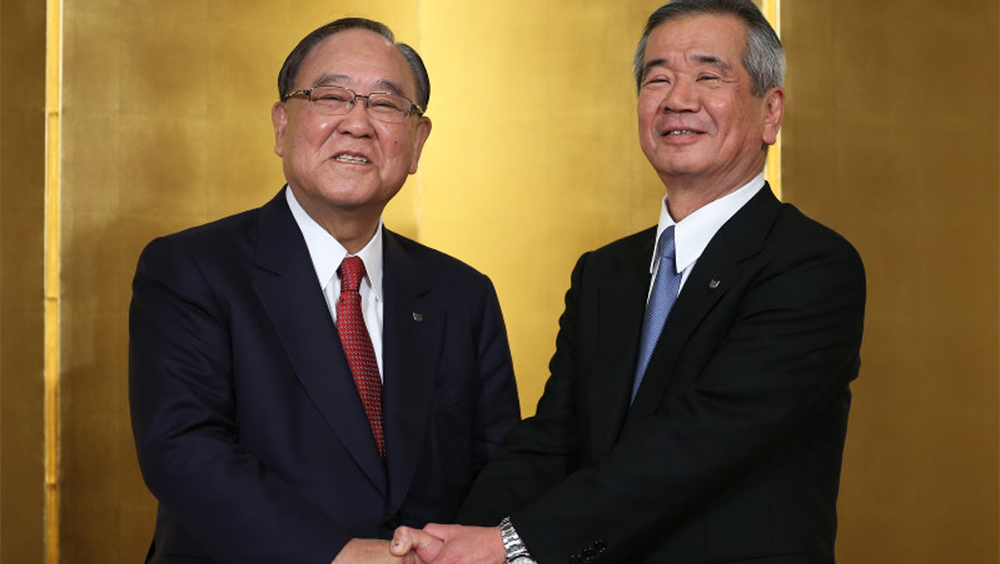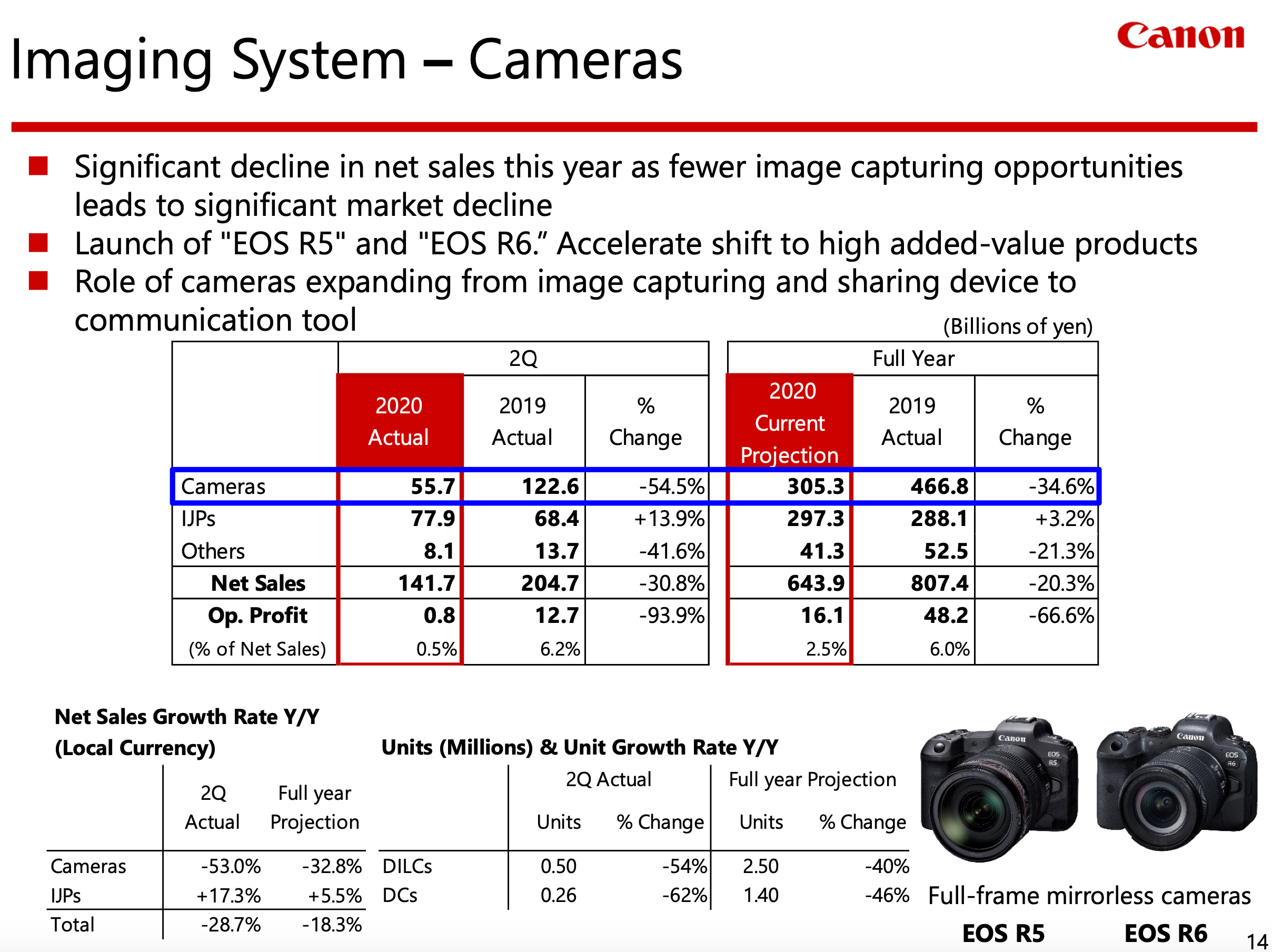
Profits at Canon’s camera division were down 93.8% year on year in Q2 2020 in part due to COVID-19. The 3 months ending June saw lockdowns and a global pandemic take hold across the world. The loss of life and livelihood is the important and most sad aspect of 2020, indeed the saddest time in my lifetime. My heart goes out to anyone who is mourning the loss of a loved one or suffering from a lack of work and derailed plans. In this article though I’d like to focus on Canon’s dire financial results from Q2 and the impact of coronavirus on the camera industry, and how it can respond. This proud industry, as well as the photography, video and filmmaking sector has been particularly badly hit by COVID-19.
I would also like to address Canon’s two most important camera releases of the decade, the EOS R5 and R6. After a faltering launch, with my sources saying that new shipments are delayed until November, only a very small number of cameras are currently with distributors and retailers. This first batch was shipped before the full furore over overheating, which revealed the EOS R5 and R6 to be basically defective products that don’t do as claimed by Canon’s advertising. Now, businesses and viruses are one thing but we need to talk about ethics and morality too. Can Canon executives look in the mirror this weekend and honestly be satisfied to put these two defective cameras out into the world without any adjustments or hardware changes?
Going forward there is only so much Canon can blame coronavirus. Indeed sales of many technology devices and consumer electronics went up during lockdown with Amazon sales in particular seeing an increase of 40%.
With cameras however, especially those “high value added” models which cost $4000 the market conditions are now extremely severe. There are fewer opportunities for photographers and filmmakers to work at the moment and the last thing the majority of them need is to spend $4000 on a high-margins mirrorless camera that doesn’t work as advertised. What is the body of materials cost of an EOS R5 body? $200? $500? I don’t know but there is a lot of profit in $4000. Plus $3000 on a single lens? How can it be justified? A new system means a new investment in lenses and at a time like this can the majority of pros really justify it?
Consumers, hobbyists and advanced enthusiasts were also a target for the new Canon mirrorless cameras. Many consumers, tempted away from larger cameras by smartphones and the entry level consumer camera market practically waving a white flag in response, are seeing fewer opportunities for holidays and social events. So it is going to be hard for them to justify a fancy camera purchase in the region of $2500 for an R6, along with serious financial uncertainty in many families.
The camera industry is going to need our support, but first in my opinion there must be a change in management at Canon and Nikon.
Overheating is not a feature it is product defect that no large company should tolerate. It dents the confidence of all customers intending to use it as it was sold and marketed. In addition the inability to supply a country the size of Germany with more than 70 cameras at launch is according to my sources a complete disgrace.
In addition for the longest time now without meaningful change in the most senior upper management at Canon and Nikon, they have failed to lead the camera industry out of the smartphone fog. The ongoing advancements in computational photography and larger 1″ sensors in smartphones threaten even enthusiast level mirrorless cameras in the long term. Even today the 8K shooting Samsung S20 Ultra with folded telephoto optics points to a dark future for Canon.
So as leaders of the camera industry, Canon and Nikon MUST take the MOST responsibility for its overall direction. It is now time for investors and shareholders to seriously question the management at the most senior level. They should question why a younger than 84 year old CEO at Canon has not been tolerated until now. The hierarchical age related cultural issues in Japanese businesses must change forever. We need youthful energy, we need open honesty, less hubris, and new ideas to command the direction of a company as respected as Canon.
The EOS R5 overheating represents a failure of management oversight. You have a marketing division trying to sell it as a professional 8K cinema camera. On the other hand, you have a manufacturing process probably very far from the 7nm silicon node needed to make this a practical, reliable reality.
The job of senior management is to have oversight over both manufacturing and marketing divisions, to make sure that if one promises something, engineers can deliver.
And if a major problem with video gets flagged up close to launch, an engineer must be able to speak out to the most senior people in the company without fear of overstepping the mark due to an experience or age gap.
Canon ambassadors and testers – Did they miss it or play it down?
Canon’s ambassadors, testers and professional photographers meanwhile almost all need to be removed. In many cases, and in my opinion, I don’t think tough accurate feedback on video was provided to Canon or taken on board by senior management.
Canon assumed the overheating issues would fly.
Serious problems didn’t seem to be flagged where necessary and I realise many of Canon’s testers are professional photographers who probably don’t even use a video mode in their day to day business.
Well this has to change and just like Leica are doing, Canon need better representation in video feedback and tougher feedback. Firmer feedback. Fewer ‘yes men’. Indeed fewer men. More female representation at every level of the company and they should listen to people like me if there is a problem on the video side.
Not once has Canon communicated with me in the build up to the EOS R5 launch or asked my opinion. If their cameras lack a passive cooling design, who is to blame? Yes that’s right. Canon!
With the financial results so appalling, Canon apologising isn’t enough. They have to take concrete action to ensure the camera division survives the smartphone revolution long term and deliver reliable cameras that do what the marketing says they do.
Read the full financial results from Canon here
On a positive note
As Fuji’s CEO says in his book innovating out of a crisis, new opportunities often come from a challenging situation and just as the photographic film camera market began to vanish, so a new opportunity appeared in the form of digital photography. It is the same with computational photography, digital services, apps, 5G and AI. So here is the strategy I believe Canon should employ in the short and medium term:
- RECALL THE EOS R5 and R6. I cannot stress this strongly enough. It is both RIGHT, from an ethical standpoint, RIGHT from a customer perspective, RIGHT for the business direction, and helpful to long term sales and trust in reliability. I am sure a lot of ‘ass covering’ is going on at Canon right now but they have to face facts and remove those responsible for the mess. Implementing the correct passive cooling design and processor efficiency to handle the high data rate is CRITICAL along with firmware changes and a higher thermal cut-off option like Sony in the menus. We do not expect to record 1 hour of 8K. What we DO expect is predictable, repeatable high quality oversampled 4K in all normal shooting conditions including in the Summer. If there is a 30 minute limit in 4K, Canon must make sure the limit isn’t sometimes 10, sometimes 5, sometimes zero, after not even recording any video (just using the camera in live view).
- Cooperate with me. I have been here for 10 years advocating for Canon to make better decisions for their customers on video and mirrorless. Only once did Canon ask for my feedback and that occasion was used simply to try and rope me into a PR relationship. If Canon faces up to honest and frank factual criticism, things will get fixed before they are even broken.
- Enter the smartphone and digital services imaging market like Samsung and Apple. Imaging is a huge Canon market. Why is Samsung in this market, adapted to modern times, but Canon isn’t? Diversify and invest in online services! Unfortunately the time to buy Adobe, Instagram and a smartphone company like HTC has long since past… so Canon will find it difficult to enter the modern imaging market now. It still must be considered as a top priority, even with the high risk of failure.
- Maintain the soul and DNA of photography and cinema. Do not sweep it under the rug with new concepts. Combine the timeless with the new.
- Introduce new ideas and younger management at senior levels in Japan and hire more key people from outside Japan.
- Reduce the margin of camera hardware. Subsidise hardware with software profits and digital services.
- R&D funding should remain as high as possible during times when innovation is the only way out of trouble. Do not be tempted to prioritise short time profit at the expense of long term strategy and product innovation.
- When exploring new opportunities make sure they are long-term and culturally valuable – Canon MUST be careful with short term trends like action cameras, webcams and ZOOM meeting cameras. It would be sad for all the photographers and filmmakers in the world if Canon prioritises a webcam over development of mirrorless cameras.
Yes, the next 12 months are going to be difficult. Whether you are a photographer, a filmmaker, an engineer or a camera company, the entire industry is in for a prolonged downturn. There could be a second wave or even a third wave of coronavirus with all the highly damaging socio-economic restrictions that go with it. So this is the key time to take stock, and to really consider thinking outside the box.
To innovate out of a crisis.
The evolutionary Kaizen philosophy is wonderful and one of the many special things about Japanese culture, but it cannot come at the expense of the occasional revolution and conceptual experimentation should be first and foremost in the minds of the top management.
There must not be the temptation to close up like a withering flower, hoping to bloom again next Spring.
There may not be a next Spring.
And as for the ethics of the overheating drama. This MUST be addressed in two ways: Now. And urgently.





